Last Updated on October 12, 2024 by Dawn Head
We have been in Argentina for several weeks and were excited to have the opportunity to visit Iguazu Falls National Park.
Located in northeastern Argentina, it is an amazing place to view incredible wildlife, exploring the many trails, and watching the breathtaking falls.
After spending time in fast-paced cities like Buenos Aires, it was wonderful to slow down and be closer to nature again, like we were in Chacra Millalen, volunteering on an organic farm.
Terrifyingly Awesome: Iguazu Falls, Argentina
We were greeted in Puerto Iguazu, Argentina (after a 20 hour bus ride) by dark clouds, cool weather, and pouring rain.
It continued to rain all afternoon Friday and into Saturday morning.
When the alarm went off at 7am on Saturday morning I jumped out of bed excited to get to the Falls, but it was still overcast.
We had decided that if it was raining we would stay a few more days in order to experience Iguazu Falls at its finest, so we went back to sleep.
By the time we got up a little while later the sky was clearing, so we took our chances and went to the falls.
It turned out to be one of two magnificent days at Iguazu Falls National Park (Parque Nacional Iguazu).
Iguazu Falls (Cataratas del Iguazu)
Iguazu Falls consists of over 275 separate waterfalls on the Iguazu River.
One side of the river and waterfalls is Brazil and on the other side is Argentina.
Many people see the falls from both sides, but unfortunately Americans are required to get a $150 visa to go into Brazil so we only visited the Argentine side.
It is reported to be better overall, but with fewer panoramic views.
We visited Iguazu Falls National Park for two days — hiking the on and off the beaten track trails and taking in the grandeur of the falls.
Garganta del Diablo (Devil’s Throat)
Garganta del Diablo is the largest of Iguazu’s falls at nearly 500 feet wide.
To get to these falls there are a series of catwalks nearly a mile long over the river until you get to the falls themselves.
Arriving at the end of the catwalks overlooking Devil’s Throat my initial instinct was to grab hold of the innermost railing and inch back closer to land — the waterfall is literally under your feet.
Once my survival instinct subsided I was astounded by the sight and sound of the falls.
The roar of the water rushing over the falls in one I’ll never forget.
The Devil’s Throat waterfall itself is massive and immediately to it’s left (from the Argentine catwalks) are the Union and Floriano Waterfalls making for an seemingly unending series of falls.
Salto San Martin, Mbigua, Mendez and Bossetti
While not nearly as massive as Devil’s Throat, the San Martin, Mbigua, Bernabe Mendez, and Bossetti waterfalls are just as breathtaking.
There is a series of upper catwalks which allow visitors to experience the falls looking down over them, and a longer lower circuit of trails that provides panoramic views.

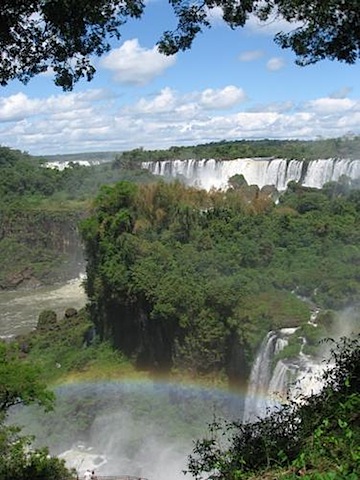
Isla San Martin
We got to San Martin Island, on the Argentine side of the falls, via a short boat ride.
From the island there is an impressive front-and-center view of the San Martin Falls.
The spray coming off of the falls was so intense on the island that some people wore rain ponchos.

The side of the island facing away from the falls gives little indication of the tumultuous waterfalls that these waters flow through.

Sendero Macuco / Macuco Hiking Trail
On our second day visiting Iguazu Falls National Park we decided to get off the tourist path and hike the Macuco Nature Trail through the jungle.
While this wasn’t exactly traditional backpacking South America, we enjoyed a more tranquil part of the park.
Although we saw thousands of people while visiting the main park, we only ran into about a dozen during our three hours hiking this trail.
It was peaceful with only the sound of bird calls and a few nature sightings.
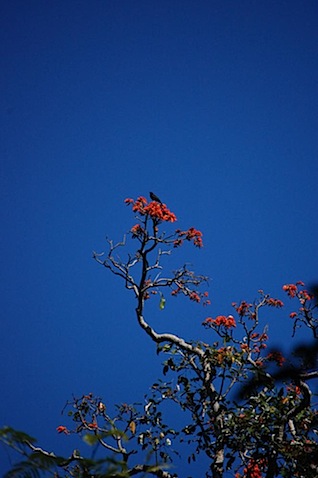
The Macuco Trail leads about 2.5 miles through the jungle to the Arrechea Stream Waterfall.
If you ever get the chance, make the trip to Iguazu Falls and the natural wonders within.
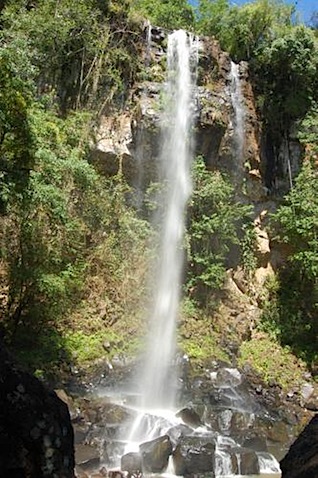
Animals in Iguazu Falls
After enjoying the fauna on Peninsula Valdes, we were excited to see what lived in this area.
We learned some of the animals in Iguazu Falls are like nothing we’ve seen before.
World’s Largest Rodent and Other Exotic Iguazu Falls Animals
Awhile ago I watched a PBS documentary about animals in South America.
It featured the capybara — which at 140 pounds — is the world’s largest rodent.
The image of a ginormous hamster-beaver-bear stuck with me, so I was psyched to learn capybaras live in Iguazu Falls National Park (Parque Nacional Iguazú). I went on a mission to find one.
Luck was on my side and a capybara did come out to pose for a photo, along with lots of other exotic wildlife. We saw everything from toucans and kites to coatis and lizards.
I was surprised to see such a wide variety of species here.
Capybara
You can’t tell how huge it is from the photo, but the capybara weighs 140 pounds and can be over 4 feet tall.
Think black bear-sized guinea pig. This one was scavenging near Garganta del Diablo (the Devil’s Throat), one of the biggest waterfalls in the park.

Spectacled Caiman
This caiman — complete with a butterfly on his head — was lounging on a rock not far from the capybara.
We learned basking in the sun is how caiman spend most of the day. The have few natural predators.

Coati
It may look cute and innocent, but there were signs throughout the park warning visitors to hide food in the presence of coati, this raccoon relative, because they’ve been known to attack for food.
So unlike the folks in this photo, I kept my distance from coatis and their sloth-like claws.
It’s also good to keep your distance between any wild animals in Iguazu Falls — and everywhere for that matter — for safety and to respect the animals in their natural habitat.

Toucan
Not the best shot of a toucan, but they don’t stay still for long! You can see its beak pointing toward the bottom of the photo.
This isn’t a toco toucan (think Toucan Sam), though we did see a few of those fly by as well.
But they were too fast to snap a picture.

Giant Ants
I have to admit I was a little bit afraid this very large ant would somehow leap off the ground and bite my hand.
But it didn’t and now you can see how huge these ants are.
I figure if a normal ant can carry a large leaf on its back, this one can probably carry a small child.

Butterflies
I’d never seen so many butterflies in my life.
They were everywhere — in blue, pink, green, solids, patterns — swarming around us as we stepped onto new paths.
One even landed on my head and stayed there for a full minute before moving on.
Plumbeous Kite
I used a super-zoom lens for this shot of a plumbeous kite, part of the hawk family.

Vulture
There was a gigantic colony of vultures hanging out on a nearby rock, with dozens more circling in the sky.
Eerie!
Even scarier is the fact that this photo was captured without the help of a zoom lens.
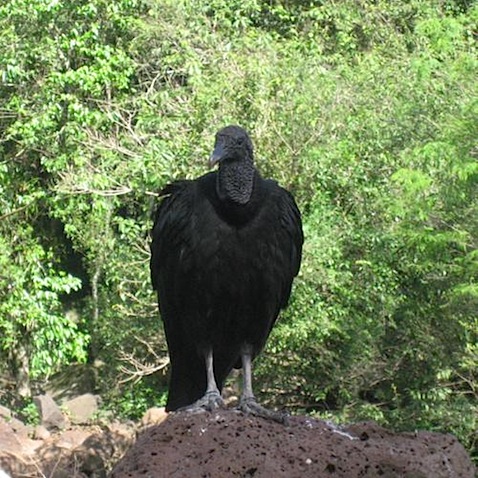
Lizard
These 3 foot long reptiles proved they weren’t afraid of people as they sunned themselves near hiking paths.
They looked intimidating, though, and we captured this shot with the zoom.

Rodents
I’m not sure what this is called, but it was about the size of a guinea pig and didn’t seem to be afraid of people.

The second I learned is an agouti and was the size of a small beagle and was much more skittish.
It ran across the trail far ahead of us.

Those were the animals in Iguazu Falls we saw in the wild.
Our next stop was a rehabilitation center were we saw even more native animals.
Guira Oga: Iguazu Falls Animal Rehabilitation Center
The bus driver saw the sign, slammed on his brakes, and pulled over on the side of the highway to let us off.
The Güirá Oga Animal Rehabilitation Center is sandwiched between the town of Puerto Iguazu and the main Iguazu Falls Park entrance.
We could have easily missed it, but I’m so glad we didn’t.

As the only visitors there, we got our own personal tour guide.
José, the son of a national park tour guide, grew up in Puerto Iguazu and recently returned from university in the province of Neuquen.
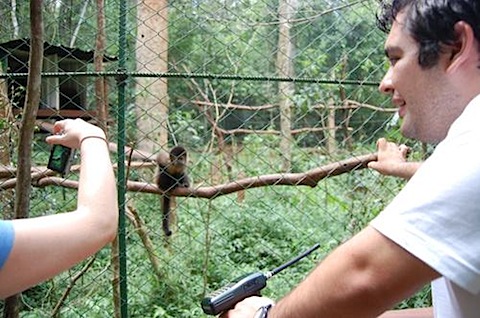
To begin the tour, we rode to the head of the trail in a wagon attached to a Güirá Oga truck.

Güirá Oga’s mission is to rescue, rehabilitate, and reintroduce injured or endangered animals to Iguazu Falls National Park.
They function as an animal hospital and rehabilitation center focusing primarily on birds, although plenty of cute furry animals are also rehabilitated at the park.
During our hour-long tour, we got to see up close many of the animals we saw at Iquazu Falls, plus others like the Capuchin monkeys and Oso Melero.


The most surprising and confusing part of the tour was when José showed us the nutrition/food preparation building.
He told us about how Güirá Oga grows partridges and mice. Despite José’s excellent English, we didn’t understand right away.
They breed the partridges and rodents at the center to feed to the other animals.

Unfortunately, because it was a Sunday and during siesta hours we didn’t get to see any of the hospital veterinarians in action, but we learned a lot about the animals and the park during our tour.
Güirá Oga does excellent work, and we enjoyed supporting it.
With so many falls to visit at Iguazu Falls National Park in Argentina, we could have stayed much longer.
It was a wonderful experience; one we would recommend to anyone.
The wildlife at Iguazu Falls was diverse and fun to see as well.
And while you are in the area, be sure to visit Güirá Oga Animal Rehabilitation Center, which rehabilitates animals for release to Iguazu Falls National Park.
In addition to the falls, the wildlife in Iguazu Falls were the highlight of the visit.
After our visit, we were excited to see more animals at the next destination.
Peninsula Valdes ~ Fauna and Whale Watching
Peninsula Valdes in Argentina is the only place on the planet where Orcas beach themselves to catch seals.
Of course, that only happens at certain times of year, and even then, it’s rare.
We were blessed with the opportunity to travel to Peninsula Valdes and enjoyed every minute of this magnificent place.
This nature reserve is a sanctuary for wildlife.
After much research and meeting with other green travelers on past excursions, we knew if we ever went to Argentina, we wanted to visit Peninsula Valdes, so that we could experience the amazing fauna and see the southern right whales on the whale watching tour.
We were also excited at the prospect of seeing penguins.
What could be cooler than penguins on a beach?
We arranged our whale watching tour for later in the week.
In the meantime, we debated going on an arranged tour of Peninsula Valdes, but we’d heard they can be a bit rushed. We really wanted to take our time.
So we paid a bit extra, and the owner of our hostel gave us a private tour of Peninsula Valdes.
The desert-like landscape was fascinating and so unlike other parts of the country, including our time enjoying volunteering at Chacra Millalen, an organic farm in Argentina.
Diverse fauna in Peninsula Valdes
We didn’t see any Orca whales, but the elephant seals, penguins, ostrich-like rheas, llama-esque guanacos, seals, and seal lions more than made up for it.
Please note, wherever we go, we never, ever touch, feed, purposely come close to, or disturb wildlife in any way.
This peninsula is a sacred habitat for so many species and also has a huge tourism population.
It is so important to be respectful of the surroundings here.
Rheas & Guanacos
We were less than 10 minutes into our tour when we spotted a rhea (similar to an ostrich) with 11 chicks on the side of the road.
Our guide told us they usually have 10-12 babies in a litter.
Next we were fortunate enough to see some guanacos, llama-like animals that are abundant on the peninsula.
They often travel in groups of five or more, but we found these two alone.


Penguins
Then we stopped at my favorite point where we saw penguins.
When we first walked toward the rope that keeps people off the beach, we were disappointed because we didn’t see any penguins in the distance.
Then we looked down, and there they were, just a few feet away.
This penguin greeted us with a wave and stayed posed for lots of photos.

This cutie was standing close to us.

This penguin and many others on the beach were nesting.
We didn’t see any hatched chicks.
This penguin decided to take a dip in the ocean right before we left.
It’s interesting how much penguins look like ducks when they swim.

Elephant Seals, Sea Lions & Baby Seals
There were signs on the beach with sketches of male, female, and baby versions of these seal types, but from 200 feet away it was virtually impossible to distinguish one from the other.
The females are nearly identical, at least to my untrained eye.
But I’ll do my best labeling them.
One of the most fascinating parts of this experience was listening to the noises the animals make while they splash around in the water.

We weren’t sure which animal we were photographing when we took the picture, but based on its ginormous size (males can weigh up to 7,700 lbs), we were guessing an elephant seal.
Looks like we were right — see its trunk-like nose?
This little fellow was sleeping by himself on the beach sunning himself.
For the most part, all of the seals and sea lions looked like this — inactive to the point of being lifeless.
But no worries.
That’s just how they roll.

One of my favorite parts was seeing the sea lions walk out of the water using their feet-like fins.
See the trail of footprints this one left behind him?
These two are male sea lions, which you can tell by their thick necks.

Birds and Lizards
We saw so many interesting species on our visit to Peninsula Valdes.
We caught a glimpse of this pretty red bird off of a hiking trail near the beach.

There were also so many lizards on the beach trails near the sea lions and penguins.

The Salt Lake
Our guide pulled over on the way back to show us this expansive salt lake.
He said it was almost entirely salt, with very little water, and that they don’t take salt from it to eat.
It was difficult to capture its size in a photo.
It remains one of the most interesting things I’ve ever seen.

Whale watching off Peninsula Valdes
Whale watching off Peninsula Valdes is a big business here, and it was on our list of things we were going to be sure to do.
We were hoping to see whales called southern right whales.
We learned from our guide that usually southern right whales spend summer in the Southern Ocean which surrounds Antarctica.
They migrate north in the winter for breeding and are often found on the coasts of Argentina.
Our small boat rounded the corner into a bay of the Gulfo Nuevo in the Atlantic Ocean.
Immediately we saw three small whale tails and the mother whale’s head behind them.

During our two-hour whale watching excursion, near Puerto Madryn and Puerto Piramides, Argentina, we floated in the ocean and watched as the southern right whales nursed, played, and swam under our boat.

Southern right whales average about 40 ft long and weigh 27 tons.
It is reported there are only about 8,000 of them left in the world, 400 near Peninsula Valdes, because they were hunted to near extinction.
Hunters favored them because they are slow and float on the water’s surface when killed.

Southern right whales also float when they’re nursing.
We learned that of the three babies (ages 4-6 months) we saw, only one was this mother’s.
The guides recognized a second as an orphan who has been nursing from other mothers in the area.
Although not all mothers will nurse an orphan.
They didn’t know where the third baby came from.
While this whale let him nurse on this particular day, we learned it was unlikely she would continue to do so as each baby eats over 200 liters of milk a day.
Another interesting fact: Southern right whales have hair in many of the same places humans do, like eyebrows above their eyes.

Sadly, even with the ban on hunting, these whales are still not safe from predators.
The seagull population has expanded rapidly, and one seagull colony has started eating off live whales’ skin.

The southern right whale has incredibly sensitive skin, and the seagulls bring infections.

Despite this depressing fact, I couldn’t be anything but awestruck at these majestic creatures.
They swam close to the boat and made magical whale noises.
The tour operators stressed the importance of being quiet.

It was a magnificent two hours and money well spent.

A visit to Peninsula Valdes affords one an up-close experience of the wildlife and beauty that abounds here.
It is an important nature reserve that is very important to our ecosphere.
Later in our travels we saw the majestic Magellanic penguins at Punta Tombo, which was also incredible.
We were excited to see penguins and penguin chicks in Punta Tombo Argentina.
After seeing lots of them at Peninsula Valdes, we wondered how much different it would be visiting here.
Home to over 600,000 Magellanic penguins, it’s one of the largest penguin colonies in the world.
But we said “why not?” and booked the trip to Punta Tombo reserve, just south of Trelew, Argentina.
It turns out that seeing thousands of penguins in one place is exponentially more exciting than seeing a few dozen.
Penguins at Punta Tombo
The Magellanic penguins return to Punta Tombo year after year from September to April to nest and raise their chicks.
We arrived just in time to see the newly hatched chicks.
The parents share responsibility for the chicks.
While one sits on the nest, the other goes out to sea to find food.
My favorite part was when the penguin parents would tire of standing over their chicks and suddenly just plop (like a belly flop) right on top of the chicks.
It seemed like the chicks would get squished! Penguin chicks are so adorable.
We couldn’t decide between using our DSLR vs Point-and-Shoot camera, so we used both, just as we did while visiting Peninsula Valdes, Iguazu Falls, and Tikal National Park.
While these pictures seem close up, we were actually keeping a respectable distance, to be respectful to all wildlife.
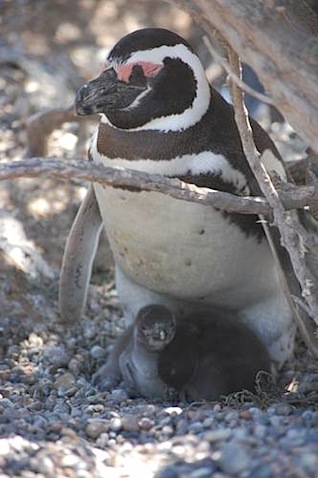

Punta Tombo





Memorable time at Punta Tombo
Our visit to Punta Tombo was incredible.
Seeing thousands of penguins across the beach, adorable chicks, and penguins diving into the ocean was a truly unforgettable experience.
Stepping on penguins? Dilemmas in green travel
While I was at Punta Tombo, however, I felt we got a little too close for comfort.
Take one step without looking, and I could have literally stepped on a penguin.
We were warned to “not get too close.”
But what is too close?
No one told us the specifics.
Many tourists leaned within feet of the penguins just to get better pictures.
And of course the tour group was loud.

It was difficult to know our immediate impact.
It seems like in order to build the walking trail years ago, some nests would have had to be moved or destroyed.
And since the penguins return to the same nests year after year, what happened to the penguins whose nests were in the way?
Penguin population at Punta Tombo is getting smaller
Sadder still is that the penguin population is slowly dwindling.
The pollution and over-fishing in the Atlantic Ocean means that the penguins’ food sources are dying and moving further from shore.
Thus the penguins have to swim further away from their nests to find food.
Penguins are monogamous and share parenting duties.
One parent guards the nest while the other goes for food.
But because its partner is gone longer in search of food, sometimes the penguin on the nest will starve by the time the other returns.
Or the nesting penguin may abandon the nest to get food — leaving the eggs or chicks unprotected.
When that happens, the penguin is often so near starvation it dies before it even gets to the water.
And we were told that the chicks are getting smaller because they aren’t fed as frequently.

While I loved the opportunity to take lots of cute photos of penguins at Punta Tombo, I was struck with the dilemmas of being an environmentally conscious traveler.
How do I justify disturbing this place? And what can I do to prevent the pollution that causes these penguins to starve?
I felt a bit guilty after visiting Perito Moreno Glacier and Peninsula Valdes as well.
Both, like Punta Tombo, are major tourist attractions. Yet, they all come with a cost of destroying the natural habitat, little by little.
People and companies are profiting; tourists are “experiencing;” yet, the flora, fauna, and other natural surroundings are the ones who pay the price after thousands of people come traipsing through, year after year.
The visit was a reminder of how interconnected people and animals are, and that traveling doesn’t come without costs.
With the holidays just around the corner, a lot of us will be traveling.
Let’s try to make an even greater effort to be a little more environmentally conscious.
Whether it’s bringing a reusable water bottle to the airport, parking further away rather than driving in circles looking for a parking spot at the mall, or wrapping presents in the Sunday comics, every little bit helps.
While Punta Tombo was a wonderful experience, because I strive to be a green traveler, it is difficult to say whether I would recommend it or not.
Like the glaciers and other natural spaces, too much “people intervention” is detrimental.
I believe people, for the most part, try to do their part to respect their surroundings while visiting these places, in this case, the penguins, penguin chicks, and nests.
However, it is still invading on their natural habitat.
Perito Moreno Glacier Argentina – Great Glacier Pictures
We were in Argentina for two months and had Perito Moreno Glacier near the top of our list of things we wanted to see.
We always try to experience as many outdoor respites as possible, as we usually prefer nature-made over man-made.
Already we had enjoyed taking in the natural grandeur of Peninsula Valdes and Iguazu Falls.
We were anxious to see Perito Moreno Glacier, a major tourist attraction in southern Patagonia, in southwest Santa Cruz Province of Argentina.
This glacier is one of three in Patagonia that is not retreating.
We also learned that this field of ice is the world’s third largest reserve of fresh, not salt, water.
Located in the Los Glaciares National Park, Argentina’s Perito Moreno Glacier is something to behold.
We took at least 1,000 glacier pictures that day as we couldn’t get over the beauty of the glaciers.
Of course, photos never can capture the true magnificence, but we still tried.
We were so lucky to have experienced the Perito Moreno Glacier
We had been in Argentina for months exploring so many places.
The magnificent Perito Moreno Glacier was the last of the “big things” we wanted to see.
Afterwards, we had several weeks to explore the rest of the country at our leisure.
Some of the other stops we made included Trelew, Punta Tombo, Mendoza, Maipu, and San Martin de los Andes.
Places we went to in addition to Perito Moreno Glacier
Trelew: Real life in Argentina
“What are you doing here?” a local teenager asked us after he learned we were from the United States.
Trelew isn’t exactly the top spot on most “Places to Visit in Argentina” lists.
But perhaps it should be.
Situated between Puerto Madryn, Punta Tombo, and Gaiman (a Welsh village with tea houses), Trelew is a great stop for anyone on an extended visit in Argentina.
Because so few tourists visit, cheap accommodations were hard to find.
But if you do decide to stay, you’ll be rewarded with a true taste of Argentine life.
We stopped here during the middle of our trip for five days to relax and get some work done.
While there, we enjoyed doing things Argentines do: shopping for groceries and chatting with the checkout person; ordering and waiting for made-on-the-spot empanadas and sampling Argentina parrilla; and sitting on the park bench in the center of town watching kids throw water on each other to celebrate the end of the school year.
Because it was November, not exactly the end of the school year for Americans, it took us a while to figure out what the teenagers were doing when they were ripping up notebooks, playing drums and singing, and flinging liter bottles filled with water.
In Trelew, there’s also a paleontology museum with some interesting exhibits — including one where visitors can touch a real dinosaur bone.


We stayed in an apartment with a view of the city.
There was a fantastic owner, Miguel.
I accidentally left some posters at the apartment, and a few days later Miguel emailed and arranged to ship them to us in Buenos Aires, where we were going to be at the end of our trip.
I am so thankful to him for doing that.
If you’re on extended trip in Argentina and looking for a place to sit back, relax, and settle down for a few days, check out Trelew.
AfterbPerito Moreno Glacier, we made our way to Mendoza
Buses and buses.
We were excited to take the trip to Mendoza, the heart of Argentina’s wine region.
We were looking forward to a wine tour by bike.
Is is hard to believe we could be on a boat beholding the amazing Perito Moreno Glacier and then days later be on a wine tour by bike in Mendoza.
We also thoroughly enjoyed the fine Argentine cuisine and the typical Argentine breakfast in Mendoza.




Hiking to the Mirador Arrayan Tea House: San Martin de Los Andes
After experiencing the amazing Lake Agnes Tea House in Lake Louise, Canada, I was excited to learn that San Martin de los Andes, Argentina has the Mirador Arrayán Tea House.
The local city guide pamphlet promised the tea house would have “excellent bakery pastries that can be also appreciated … and eaten.”
Appreciated and eaten?
I’m there.
We set out for our 10 km hike late morning on the part paved, part dirt road that leaves San Martin de los Andes near Lake Lacar.
San Martin is a cute town of about 20,000 people nestled in a valley in the Patagonian Andes.
A gorgeous spring day with just a few clouds in the sky provided the backdrop for our hike and within 15 minutes of our hike we had a spectacular view of the city below.

Despite the trek being on a road and not a trail (you can drive to the viewpoint) we only saw a dozen or so cars.
The hike was peaceful, and we made it to the Mirador Arrayán in about an hour.
We marveled at the view, trying but failing to capture its majesty on film.
Glancing to the west you see the entirety of Lake Lacar with snow capped mountains in the background.

Looking to the east is the city of San Martin de los Andes.

We hiked the 1km further up the road, looking forward to the Mirador Arrayán Tea House, and to appreciating and eating its pastries.

We approached the Tea House, only to find a sign on the door indicating their hours of 4pm-8pm.
We weren’t going to hang around for another four hours so we turned back to the lookout point, lunching instead on our backup food– smoked trout and cheese, a local specialty.
I guess we’ll never experience the Arrayán Tea House’s pastries, but the view and serenity were well worth the hike.
Bike & Wine Tour in Maipu: It’s Better After a Bottle
We had high hopes for our wine tour by bike through Maipú, in the heart of Argentina’s wine region.
What could be better than a leisurely bike ride through a cute old town with wineries on one side and the Andes on the other?
But our experience didn’t quite match up with our expectations.
We hopped off the bus in Maipú and rented two rickety bikes.
Winery map in hand, we started pedaling toward the first winery.
Based on the map, it should have only been a few blocks away.
Then again, the map didn’t have a scale.
Eight kilometers later we pulled into the old-fashioned bodega, exhausted and happy to be there.
The bike shop didn’t have any helmets and the bike lane ended after a few blocks.
The wine route turned out to be a run-down major road, with cement trucks whizzing by at 70 mph, barely swerving to avoid us and kicking up dust and spewing exhaust in our faces.
Not quite the majestic, peaceful experience we’d hoped for, but we tried to look on the bright side.

Not the scenery we’d imagined
Two large dogs greeted us at the first winery, which consisted of five unlabeled buildings.
We ventured into one and found a winery tour in progress.
We tagged along for 15 minutes during which I learned.
You should always store wine on the first floor of your house and the bottle should be kept horizontal.
When you buy wine at the store, take a bottle from the back of the shelf because it’s been exposed to less light.
At least I think that’s what the guide said.
It was all in Spanish, and I struggled to keep up.
Then the tour group went to do a tasting, which was a bit too expensive for us, and we left.
The next winery looked close, but I feared the map might be deceiving us again.
Fortunately, it only took 10 minutes to get there, and this bodega was much more scenic, less busy, more reasonably priced, and served food.
That’s more like it.
We did the tour, ordered a delicious meal, and proceeded to split a bottle of wine.

Wine and food — that’s more like it
Feeling content, we stopped at one last winery.
We walked through its museum and saw an entire cow skin that had once been used to filter wine.
We sampled one of their wines, then decided it was time to call it quits for the day.
We headed back to the bike shop, stopping only to sample exotic liqueurs at a store along the way.
A delicious but bad idea after aforementioned bottled of wine.
Content after a five hour day of bodega tours, we returned our bikes and got on a bus headed for Mendoza.
The day wasn’t what we expected, but we still had fun.
With good weather and good wine, you can’t go wrong.
A wonderful time at Perito Moreno Glacier and afterwards
We were lucky to be able to have time to explore Perito Moreno Glacier and many more cities while spending time in Argentina.
The Perito Moreno Glacier is a must-see spot. Given the extra time we had, we were fortunate to also experience off-the-beaten-path locales of Trelew, Punta Tombo, Mendoza, Maipú, and San Martin de los Andes.
Related Posts:

